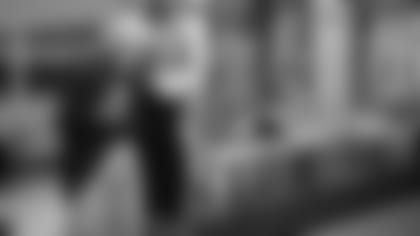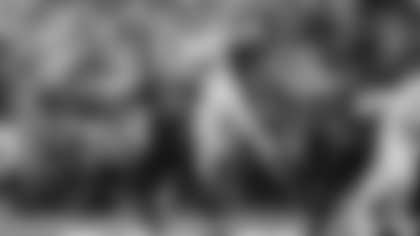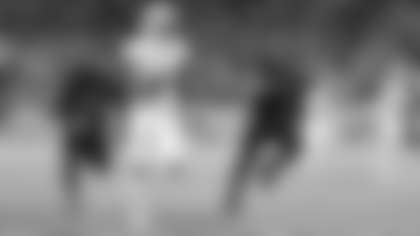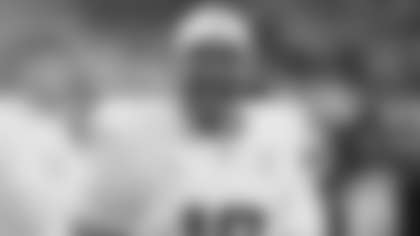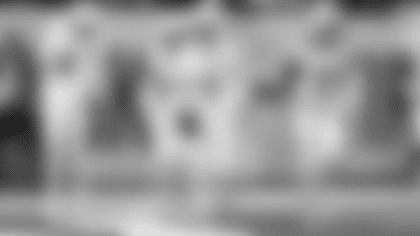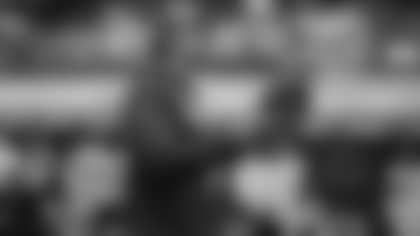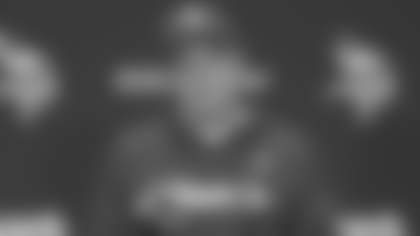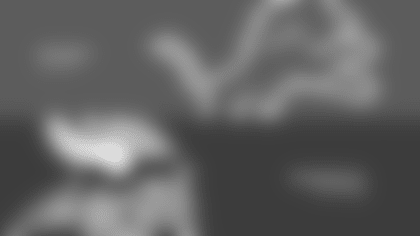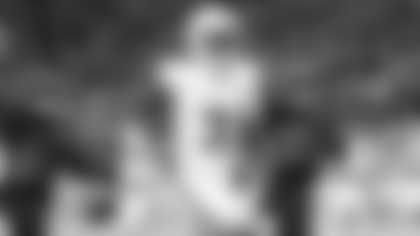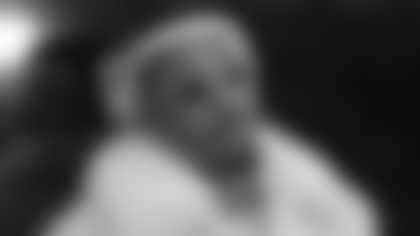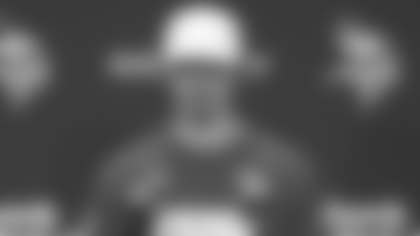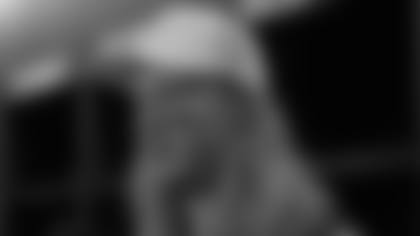EAGAN, Minn. – Long before the Vikings took the field at U.S. Bank Stadium for the 2018 season, generations of players and coaches built the franchise since its inaugural 1961 season.
From the designing of the Norseman logo, to the hiring of Bud Grant as the team's second-ever coach, to teams that advanced to Super Bowls and NFC Championship Games and even the Minneapolis Miracle, stories of the team's history are all told in the Vikings Museum, which opened in July.
Vikings Director of Brand & Creative Erin Swartz played a major role in the planning of the museum and led a group through various phases – researching, acquiring artifacts, designing, writing and creating – in order to make the dream of a Vikings Museum into a reality.
I recently sat down with Swartz to talk about the Vikings Museum and her experience with such a large-scale project.
Q: How long was a plan for the Vikings Museum in the works?
A: It's been sort of in our purview for probably a decade. Specifically when we started building U.S. Bank Stadium and kind of got a visualization of the layout and where things could fit, we thought really strategically about what we wanted this museum to be and where we wanted it to be – and it felt like, because this really was a collection of the most important pieces of our history, we wanted them to be close by. So it was important for us to create a museum space here at Viking Lakes, where we can invite the fans 360 days a year to come and see those items. So since at least 2014, there was a vision to building it here.
Q: What excited you most about this project?
A: I'm from Minnesota, born and raised, and I've been a Vikings fan since birth. What I love about being a Vikings fan, especially from the brand perspective, is how these stories throughout history have impacted our fans and players alike. Everyone can go back to that moment that they remember – whether it's going to the Met with their dad or being there for the first game of the Metrodome, seeing the Miracle at the Met. These moments that sort of crystalize in people's minds, and telling those stories in a way that was fan-centric, I loved that idea. Yes, let's tell the stories of the franchise, but let's do it in a way that the fans can say, 'Yeah, I was there.'
Q: What facets of your past career experience lent itself to diving into such a big undertaking?
A: I got my career started with The Walt Disney Company, and specifically Radio Disney, which I feel like really gave me a front-row seat on how to really do brand. What was cool about Radio Disney as a Disney property is that they thought of it as a grass-roots advertising mechanism. It was really about Disney, the street team, being out at the malls, at events, playing the music and selling the brand. It was more about their presence … and that's sort of how I learned brand at a very grass-roots level. How you present yourself matters.
That really helped me frame this of thinking of a brand as 'Who do you want to be?' And then how can you show fans that you're that? When I put that all into the perspective of the museum, long story short, I think about who we are as the Vikings and what we want the fans to come away with and remember. And this museum is just the ultimate project [that allows fans to] walk in, spend an hour or two there and come out with a really clear story and narrative of who the Vikings are. It gave me a chance to sort of build that story from the beginning.
Q: What was the process of nailing down what exhibits should be in the museum?
A: It started as sort of an internal committee from all different walks of the organization, and we asked the question, 'What do we need to talk about? What are the stories we need to tell?' And from there, we created a master list that we then whittled down or, for example, what things could be combined to tell the same story. When I go into his museum, what am I expecting to see? What are the stories that fans need to see? Because that's the memory that they carry with them. That's why they see in the museum the '87 team, the '98 team, the '09 team – because we recognized that generations of fans would be coming in, and there would be a team that spoke to them. They could go to the museum and say, 'That was my team. I remember being at that game.'
You know, fans would expect to see [Hall of Fame Coach] Bud Grant, but what did we want them to know about Bud Grant? Not just that he was a Vikings coach but what an incredible athlete he was in his early days. There are some amazing things about Bud Grant that don't really have anything to do with the Vikings directly but were important for us to tell. It was sort of that more complete picture.
Q: What did you most appreciate about working with Vikings Legends and fans to build this unique collection?
A: My greatest memories of building that space will be the time that I got to spend with Bud Grant, creating both his office at Twin Cities Orthopedics Performance Center and his display in the Vikings Museum. I got a chance to meet with him really early on and explain to him that there would be an office here for him forever – and an exhibit talking about him at the museum – and what did we want those spaces to look like? He invited me into his home, and we went through every single room. He gave me so many little nuggets of wisdom that I won't forget. [That was so] rewarding, to get to know him in that regard.
From the fan perspective, what I think was so cool about it is that people have had these items, whether they've been in a barn, in their basement or on display at the town bar. But they wanted to give them to us. They felt like, 'I've got this story that I can help you tell.' … They just really wanted to be a part of it. They knew they had something special that other people needed to see, and that says so much to me about who Vikings fans are. … Every time we got something cool, I just kept feeling this overwhelming gratitude that people were as excited about this as I was.
Q: Probably hard to narrow down, but do you personally have a favorite item or exhibit?
A: Because I come from a brand background, my favorite thing is the very first drawings of the logos and the uniform. That was given to us by the daughter of Karl Hubenthal, who created them. I remember when she called us to tell us that she was cleaning out her dad's office and that she had found it. I literally was shaking, I was so excited. Weeks went by because she was on vacation, but she finally drove up from Iowa to meet with us and give it to us, and I was just overwhelmed and stunned. He had written some things on the back about why the logo was the color it was from his memory, and it's just so rare to find that – the very first sketch of a logo that now is internationally known. It was just such a cool find. I love that.
Q: What was the most challenge part of seeing this project through?
A: I think that hand-to-hand combat of finding the right items to tell the story. And to be quite frank, we were still really developing, 'What are the stories we want to tell,' and they would pop up. In something like this, there's a lot of opinions, and there's a lot of amazing stories, and you don't want to miss any of them. So I think the hardest part was feeling like I was missing something. 'What can we unearth here?' 'How can we talk about the Duluth Eskimos? That is such an amazing story. What can we do better about that to really help people understand?'It was so challenging because I felt such a sense of responsibility. Not only to the hundreds of players that had worn the Vikings helmet and the coaches, but the fans and how they felt about it. I just didn't want to miss something that meant something to them. It was such a huge responsibility.
Q: So that being said, are the current museum exhibits set in stone?
A: The thing I love about the museum is that it's a constant work of art, and we're going to keep working, changing, editing and adding. We can go back and visit some of the displays we have and make them better. We can create all-new displays about something that maybe hasn't happened yet or that maybe we didn't think of at the time. So that gives me peace of mind.
Q: What part of the overall process was the most rewarding?
A: The flip side of the huge responsibility is that it's so rewarding to have this opportunity to tell the story and put these pieces together – and then to see the fans walk through it. One of my favorite memories is in the first weekend we were open. There was a woman standing over in The Met area, and I could see her looking around just waiting to talk to someone; she wanted to tell someone that she was there and that she remembered The Met and was with her dad [at a game]. … I was like, 'Yes. This is what I wanted.' I wanted people to find moments that they could connect to so deeply and remember things about their own personal history that kind of fit into the Vikings history. So to me, that's the most rewarding.If you can go in there and find your place, your moment, that place that hits your heart string. Hopefully everyone has a moment like that somewhere in the space.
I'd also like to add another aspect: there's the process of making this great thing, but there's also the process of creating with a team. From a professional/work/development space in my life, working with that small team of us that was tasked to do this amazing project was just so rewarding. Everyone had 'the thing' that they were really good at. I was really honored to be the lead on the team, but I had such amazing faith and confidence in the group that I was really just there to sort of steer the ship. Everybody had their point of expertise and was just rolling on it. I feel like we were all really aligned and all equally passionate – it meant so much to all of us, and we put so much time and sweat and tears that just the process of doing this with the amazing team we created was the most worthwhile.
Q: What was it like to host the grand-opening event in which Vikings Legends and their families first saw the museum?
A: This idea that we had really met and exceeded their expectations. My biggest concern was that we weren't going to. So seeing them there – seeing Theo, Alan Page's grandson, put his hand in his grandpa's handprint and watch his Hall of Fame video with him, I almost started crying. It was just incredible. Or walking Bud over to his space and saying, 'Remember when I found this [proclamation] underneath the box of duck decoys in your furnace room?'
It's amazing to see it all come together. He didn't think much of it when he was scavenging his house, but then he saw the museum [and understood]. That was pretty amazing. To see [their legacies] realized in this space, I could tell that they felt, 'I'm being honored and understood and valued. I will live on here.' That was really amazing to me that they're able to share it with their families and grandkids. That's the best part.
Q: You mentioned that the museum is kind of a moving project; if fans have donations that they've been considering or that they've come across, are you still accepting them?
A: At**Vikings.com/museum**, there is a link where, if you have an item, you can**fill out the form**and tell us about your item. We don't want fans just to stop by and drop something off, because we want to make sure that those donations are handled appropriately and with care. The best first step is to fill out the form, supply some photos if you have them, and then that will go immediately to our team, who will look into it and get back to you regarding the item.



